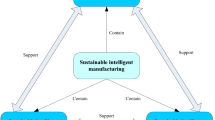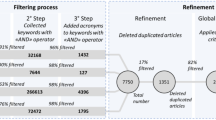Abstract
In recent decades, there have been important advances related to information technology and manufacturing. Quality and manufacturing productivity have been improved through technologies such as multi-axis machining, high-speed machining, and ultra-precision machining. This led to significant changes in manufacturing companies that were based previously on low-cost standardized products, which started to apply elements of modern manufacturing, to provide responsiveness in a context of flexible demand. Despite advances in manufacturing technologies, the language that computer numerical control machines (CNC) use nowadays is the G-code (ISO 6983 standard), which is a set of instructions that contain the movements that the machine has to perform, without any semantic content regarding the part being processed, causing the loss of much information about the product, making it difficult or impossible to share such information across different areas of the company. In contrast, the ISO 14649 standard (known as STEP-NC) provides a high-level data model related to the manufacturing process, and it has been considered adequate to overcome the problems mentioned above. In this paper is described the methodology and implementation of a CAD/CAPP/CAM system fully compliant with the ISO 14649 standard for the design, process planning, and manufacture of parts having general shapes, and it can be executed by anyone through the Internet. The parts are built with the use of features, which can contain general surfaces, enabling the user to design complex parts. The process planning method considers the possibility of using cutting tools with different diameters for removing different amounts of material from the part. The physical STEP-NC file is generated automatically by the system, and it is used as input to the module that simulates graphically the tool paths for machining the part in a three-axis CNC machine.

























Similar content being viewed by others
References
Newman ST, Nassehi XW, Rosso RSU Jr, Wang L, Yusof Y, Ali L, Liu R, Zheng LY, Kumar S, Vichare P, Dhokia V (2008) Strategic advantages of interoperability for global manufacturing using CNC technology. Robot Comput-Integr Manuf 24(6):699–708
Xu X (2007) STEP into distributed manufacturing with STEP-NC.In: Wang L, Shen W (eds) Process planning and scheduling for distributed manufacturing, Springer Series in Advanced Manufacturing, 393–421
ISO 6983 (1982) Numerical control of machines—Program format and definition of address words—Part 1: Data format for positioning, line motion and contouring control systems
Zhang X, Liu R, Nassehi A, Newman ST (2011) A STEP-compliant process planning system for CNC turning operations. Robot Comput-Integr Manuf 27(2):349–356
Yusof Y, Noor DK, Tan NZZ (2011) The development of a new STEP-NC code generator (GEN-MILL). Int J Comput Integr Manuf 24(2):126–134
ISO 14649-1 (2003) Industrial automation systems and integration—physical device control—data model for computerized numerical controllers—Part 1: overview and fundamental principles
Laguionie R, Rauch M, Hascoe JY, Suh SH (2011) An eXtended manufacturing integrated system for feature-based manufacturing with STEP-NC. Int J Comput Integr Manuf 24(9):785–799
Hardwick M, Loffredo D (2001) STEP Into NC. Manuf Eng 126(1):38–50
Suh SH, Lee BE, Chung DH, Cheon SU (2003) Architecture and implementation of a shop-floor programming system for STEP-compliant CNC. Comput Aided Des 35:1069–1083
Suh SH, Chung DH, Lee BE, Cho JH, Cheon SU, Hong HD, Lee HS (2002) Developing an integrated STEP-compliant CNC prototype. J Manuf Syst 21(5):350–362
Chung DH, Suh SH (2008) ISO 14649-based nonlinear process planning implementation for complex machining. Comput Aided Des 40:521–536
Xiao W, Zheng L, Huan J, Lei P (2015) A complete CAD/CAM/CNC solution for STEP-compliant manufacturing. Robot Comput-Integr Manuf 31:1–10
STEP Tools (2015) STEP tools Inc. http://www.steptools.com. Accessed 15 Sept 2015
Rauch M, Laguionie R, Hascoet JY, Suh SH (2012) An advanced STEP-NC controller for intelligent machining processes. Robot Comput-Integr Manuf 28:375–384
Xiao W, Huan J, Dong S (2014) A STEP-compliant industrial robot data model for robot off-line programming systems. Robot Comput-Integr Manuf 30:114–123
Liang H, Li X (2013) Five-axis STEP-NC controller for machining of surfaces. Int J Adv Manuf Technol 68:2791–2800
Hu P, Han Z, Fu H, Han D (2015) Architecture and implementation of closed-loop machining system based on open STEP-NC controller. Int J Adv Manuf Technol: 1–15
ISO 10303-238 (2007) Industrial automation systems and integration—product data representation and exchange—Part 238: application protocol: application interpreted model for computerized numerical controllers
Benavente JCT, Ferreira JCE, Goulart CM, Oliveira VG (2013) A STEP-NC compliant system for the remote design and manufacture of mechanical parts through the internet. Int J Comput Integr Manuf 26(5):412–428
ISO 10303-21 (1994) Industrial automation systems and integration—Product data representation and exchange—Part 21: implementation methods: clear text encoding of the exchange structure
ISO 14649-11 (2002) Industrial automation systems and integration—physical device control-data model for computerized numerical controllers–Part 11: process data for milling
ISO 14649-10 (2003) Industrial automation systems and integration—physical device control—data model for computerized numerical controllers—part 10: general process data
Schulz H, Schützer K (1994) FINDES—feature-based integrated design system. Prod Eng Res Dev I:189–192
Schützer K, Glockner C (1998) Integration of machine operator know-how in a feature based environment—CAD/CAPP/CAM/CNC, Proceedings of first international workshop on intelligent manufacturing systems, Lausanne, Switzerland
Schützer K, Glockner C, Claassen E (1998) Support for the development process chain by manufacturing features. In: Annals of the 3rd International Seminar on High Technology–Distributed Product Development, Santa Bárbara d’Oeste, Brazil
Schützer K, Claassen E, Gyldenfeldt C (2003) Support for the product development chain through manufacturing features. Revista de Ciência Tecnologia 11:19–27
Mokhtar A, Xu X (2011) Machining precedence of 2½D interacting features in a feature-based data model. J Intell Manuf 22(2):145–161
Dipper T, Xu X, Klemm P (2011) Defining, recognising and representing feature interactions in a feature-based data model. Robot Comput Integr Manuf 27:101–114
Oracle Java SE Desktop Technologies Java 3D API (2015) http://www.oracle.com/technetwork/java/javase/tech/index-jsp-138252.html. Accessed 28 May 2015
O’Rourke J (1998) Computational geometry in C. Cambridge University Press, 2nd edn
Zeid I (1991) CAD/CAM theory and practice. McGraw Hill
JUnit (2015) JUnit. http://junit.org/. Accessed 14 Oct 2015
ISO 10303-22 (1998) Industrial automation systems and integration—product data representation and exchange—Part 22: implementation methods: standard data access interface
Elias DM, Yusof Y, Minhat M (2013) CNC machine system via STEP-NC data model and LabVIEW platform for milling operation. In: 2013 IEEE conference on open systems (ICOS), December 2–4, 2013, Sarawak, Malaysia, 27–31
Bouard M, Pateloup V, Armand P (2011) Pocketing toolpath computation using an optimization method. Comput Aided Des 43(9):1099–1109
Held M, Lukacs G, Andor L (1994) Pocket machining based in contour-parallel tool paths generated by means of proximity maps. Comput Aided Des 26(3):189–203
Sandeep D, Xirouchakis P (2010) Contour parallel milling tool path generation for arbitrary pocket shape using a fast marching method. Int J Adv Manuf Technol 50:1101–1111
Ibaraki S, Yamaji I, Matsubara A (2010) On the removal of critical cutting regions by trochoidal grooving. Precis Eng 34(3):467–473
Author information
Authors and Affiliations
Corresponding author
Additional information
Technical Editor: Márcio Bacci da Silva.
Appendix
Appendix
Neutral file generated for the part containing a Bézier surface (Fig. 18c).
ISO-10303-21;
HEADER;
/*GRIMA*/
FILE_DESCRIPTION(
/* description */ (‘Descricao’),
/* implementation_level */ ‘2;1’);
FILE_NAME(
/* name */′′,
/* time_stamp */ ‘2013-05-21T17:39:24’,
/* author */ (‘Jc’),
/* organization */ (‘UFSC’),
/* preprocessor_version */ ‘ST-GENERATOR 5.3’,
/* originating_system */′′,
/* authorization */′′);
FILE_SCHEMA((‘COMBINED_SCHEMA’));
ENDSEC;
DATA;
#1=PROJECT(‘surface’,#95,(#2),$,$,$);
#2=WORKPIECE(‘workpiece’,#7,50.0,$,$,#9,());
#3=AXIS2_PLACEMENT_3D(‘workpiece placement’,#4,#5,#6);
#4=CARTESIAN_POINT(‘‘,(0.0,0.0,0.0));
#5=DIRECTION(‘‘,(0.0,0.0,1.0));
#6=DIRECTION(‘‘,(1.0,0.0,0.0));
#7=MATERIAL(‘SAE 1020’,’ACO SEM LIGA’,(#8));
#8=NUMERIC_PARAMETER(‘Hardness’,250.0,’HB’);
#9=BLOCK(‘piece’,#3,200.0,200.0,100.0);
#10=SETUP(‘setup’,#16,#15,(#20));
#11=AXIS2_PLACEMENT_3D(‘‘,#12,#13,#14);
#12=CARTESIAN_POINT(‘‘,(0.0,0.0,125.0));
#13=DIRECTION(‘‘,(0.0,0.0,1.0));
#14=DIRECTION(‘‘,(1.0,0.0,0.0));
#15=PLANE(‘security plane’,#11);
#16=AXIS2_PLACEMENT_3D(‘origin’,#17,#18,#19);
#17=CARTESIAN_POINT(‘‘,(0.0,0.0,0.0));
#18=DIRECTION(‘‘,(0.0,0.0,1.0));
#19=DIRECTION(‘‘,(1.0,0.0,0.0));
#20=WORKPIECE_SETUP(#2,#21,$,$,());
#21=AXIS2_PLACEMENT_3D(‘‘,#22,#23,#24);
#22=CARTESIAN_POINT(‘‘,(0.0,0.0,0.0));
#23=DIRECTION(‘‘,(0.0,0.0,1.0));
#24=DIRECTION(‘‘,(1.0,0.0,0.0));
#25=BOTTOM_AND_SIDE_ROUGH_MILLING($,$,’Bottom And Side Rough Milling’,5.0,#33,#26,
#31,#32,$,#34,#35,#38,5.0,20.0,0.0,0.0);
#26=MILLING_CUTTING_TOOL(‘R216.34-20050-AK38H’,#27,(#29),$,$,$);
#27=FACEMILL(#28,4,.LEFT.,$,79.0);
#28=MILLING_TOOL_DIMENSION(25.0,0.0,0.0,38.0,0.0,0.0,0.0);
#29=CUTTING_PART(125.0,#30,$,$,$);
#30=MATERIAL(‘P’,’CARBIDE’,());
#31=MILLING_TECHNOLOGY(0.073,.TCP.,145.0,2307.0,$,.F.,.F.,.F.,$);
#32=MILLING_MACHINE_FUNCTIONS(.T.,$,$,.T.,$,(),.T.,$,$,());
#33=CARTESIAN_POINT(‘start point’,(0.0,0.0,0.0));
#34=PLUNGE_TOOLAXIS(#36);
#35=PLUNGE_TOOLAXIS(#37);
#36=DIRECTION(‘approach strategy direction’,(0.0,0.0,1.0));
#37=DIRECTION(‘retract strategy direction’,(0.0,0.0,-1.0));
#38=CONTOUR_PARALLEL(5.0,.T.,.CCW.,.CONVENTIONAL.);
#39=REGION_SURFACE_LIST(‘‘,#2,(#25,#62,#77),#40,(#44));
#40=AXIS2_PLACEMENT_3D(‘ placement’,#41,#42,#43);
#41=CARTESIAN_POINT(‘‘,(0.0,0.0,100.0));
#42=DIRECTION(‘‘,(0.0,0.0,1.0));
#43=DIRECTION(‘‘,(1.0,0.0,0.0));
#44=BÉZIER_SURFACE(‘surface - ‘,4,4,((#45,#46,#47,#48),(#49,#50,#51,#52),(#53,#54,
#55,#56),(#57,#58,#59,#60)),.UNSPECIFIED.,.F.,.F.,$);
#45=CARTESIAN_POINT(‘control vertex ‘,(0.0,0.0,80.70195959557736));
#46=CARTESIAN_POINT(‘control vertex ‘,(0.0,66.66666666666667,0.0));
#47=CARTESIAN_POINT(‘control vertex ‘,(0.0,133.33333333333334,0.0));
#48=CARTESIAN_POINT(‘control vertex ‘,(0.0,200.0,75.06244525515102));
#49=CARTESIAN_POINT(‘control vertex ‘,(66.66666666666667,0.0,0.0));
#50=CARTESIAN_POINT(‘control vertex ‘,(66.66666666666667,66.66666666666667,76.69159506129179));
#51=CARTESIAN_POINT(‘control vertex ‘,(66.66666666666667,133.33333333333334,75.50688946724576));
#52=CARTESIAN_POINT(‘control vertex ‘,(66.66666666666667,200.0,0.0));
#53=CARTESIAN_POINT(‘control vertex ‘,(133.33333333333334,0.0,0.0));
#54=CARTESIAN_POINT(‘control vertex ‘,(133.33333333333334,66.66666666666667,80.0770010866116));
#55=CARTESIAN_POINT(‘control vertex ‘,(133.33333333333334,133.33333333333334,77.56827099442718));
#56=CARTESIAN_POINT(‘control vertex ‘,(133.33333333333334,200.0,0.0));
#57=CARTESIAN_POINT(‘control vertex ‘,(200.0,0.0,79.02632526999986));
#58=CARTESIAN_POINT(‘control vertex ‘,(200.0,66.66666666666667,0.0));
#59=CARTESIAN_POINT(‘control vertex ‘,(200.0,133.33333333333334,0.0));
#60=CARTESIAN_POINT(‘control vertex ‘,(200.0,200.0,73.37351061746433));
#61=MACHINING_WORKINGSTEP(‘WS Desbaste_WS Desbaste’,#15,#39,#25,$);
#62=BOTTOM_AND_SIDE_ROUGH_MILLING($,$,’Bottom And Side Rough Milling’,5.0,#70,#63,
#68,#69,$,#71,#72,#75,5.0,20.0,0.0,0.0);
#63=MILLING_CUTTING_TOOL(‘R215.38-20050-AC38H’,#64,(#66),$,$,$);
#64=ENDMILL(#65,4,.LEFT.,$,79.0);
#65=MILLING_TOOL_DIMENSION(25.0,0.0,0.0,38.0,0.0,0.0,0.0);
#66=CUTTING_PART(104.0,#67,$,$,$);
#67=MATERIAL(‘P’,’CARBIDE’,());
#68=MILLING_TECHNOLOGY(0.066,.TCP.,155.0,2466.0,$,.F.,.F.,.F.,$);
#69=MILLING_MACHINE_FUNCTIONS(.T.,$,$,.T.,$,(),.T.,$,$,());
#70=CARTESIAN_POINT(‘start point’,(0.0,0.0,18.55271739953931));
#71=PLUNGE_TOOLAXIS(#73);
#72=PLUNGE_TOOLAXIS(#74);
#73=DIRECTION(‘approach strategy direction’,(0.0,0.0,1.0));
#74=DIRECTION(‘retract strategy direction’,(0.0,0.0,-1.0));
#75=CONTOUR_PARALLEL(5.0,.T.,.CCW.,.CONVENTIONAL.);
#76=MACHINING_WORKINGSTEP(‘WS Desbaste_WS Desbaste’,#15,#39,#62,$);
#77=FREEFORM_OPERATION($,$,’Free form Operation’,5.0,$,#78,#83,#84,$,#85,#86,#89);
#78=MILLING_CUTTING_TOOL(‘R216.42-20030-AC32P’,#79,(#81),$,$,$);
#79=BALL_ENDMILL(#80,4,.RIGHT.,$,68.0);
#80=MILLING_TOOL_DIMENSION(20.0,0.0,0.0,32.0,10.0,10.0,0.0);
#81=CUTTING_PART(104.0,#82,$,$,$);
#82=MATERIAL(‘P’,’CARBIDE’,());
#83=MILLING_TECHNOLOGY(0.175,.TCP.,660.0,10504.226244065092,$,.F.,.F.,.F.,$);
#84=MILLING_MACHINE_FUNCTIONS(.T.,$,$,.T.,$,(),.T.,$,$,());
#85=PLUNGE_TOOLAXIS(#87);
#86=PLUNGE_TOOLAXIS(#88);
#87=DIRECTION(‘approach strategy direction’,(0.0,0.0,1.0));
#88=DIRECTION(‘retract strategy direction’,(0.0,0.0,-1.0));
#89=UV_STRATEGY(.ZIGZAG.,.CONVENTIONAL.,#90,$,#91,#92);
#90=TOLERANCES(0.05,0.05);
#91=DIRECTION(‘u direction’,(1.0,0.0,0.0));
#92=DIRECTION(‘v direction’,(0.0,1.0,0.0));
#93=MACHINING_WORKINGSTEP(‘WS Free Form’,#15,#39,#77,$);
#94=WORKPLAN(‘workplan setup XY’,(#61,#76,#93),$,#10,$);
#95=WORKPLAN(‘Main workplan’,(#94),$,$,$);
ENDSEC;
END-ISO-10303-21;
Rights and permissions
About this article
Cite this article
Ferreira, J.C.E., Benavente, J.C.T. & Inoue, P.H.S. A web-based CAD/CAPP/CAM system compliant with the STEP-NC standard to manufacture parts with general surfaces. J Braz. Soc. Mech. Sci. Eng. 39, 155–176 (2017). https://doi.org/10.1007/s40430-016-0528-4
Received:
Accepted:
Published:
Issue Date:
DOI: https://doi.org/10.1007/s40430-016-0528-4




